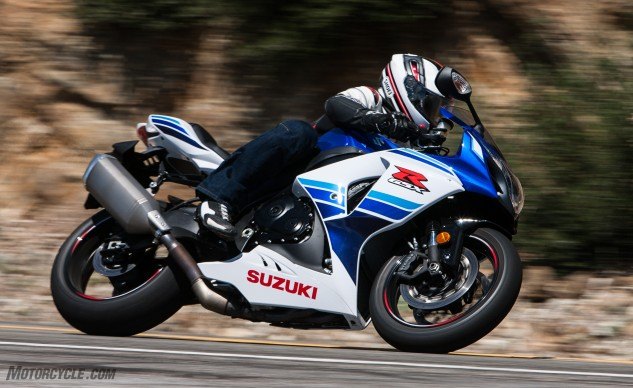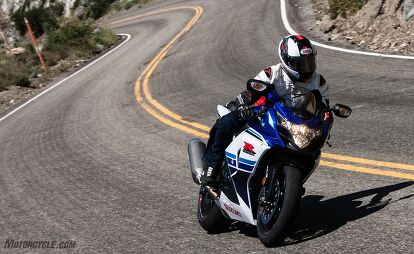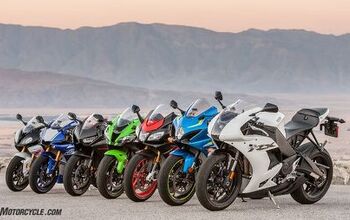Forgotten Files: 2016 Suzuki GSX-R1000 Review

Revisiting an old friend
When it comes to liter-class sportbikes, technology has become the name of the game. There’s an alphabet soup of acronyms out there to describe the many number of ways you, the rider, can lap a racetrack as fast as you can with far fewer consequences for a mistake than ever before. Yamaha, Ducati, Kawasaki, BMW, Aprilia are just a few of the manufacturers offering top-level sportbikes with sophisticated levels of electronics.
2016 Suzuki GSX-R1000
| Engine | 17.0/20 |
| Suspension/Handling | 12.0/15 |
| Transmission/Clutch | 8.0/10 |
| Brakes | 7.5/10 |
| Instruments/Controls | 3.5/5 |
| Ergonomics/Comfort | 8.5/10 |
| Appearance/Quality | 8.5/10 |
| Desirability | 8.0/10 |
| Value | 7.5/10 |
| Overall Score | 80.5/100 |
One iconic model curiously left off of that list is Suzuki’s GSX-R1000. Even in 2012 when it was last updated, the current Gixxer wasn’t at the head of its class from a tech standpoint. Now, four years on, the GSX-R1000 is really starting to show its age. With nary an electronic nanny other than selectable power modes, how does it compare in the new world order of TC and IMUs?
Quite well, I’d say. Let’s not forget that, during our 2012 Japanese Superbike Shootout, the GSX-R1000 still managed to score a solid second place finish despite going up against the latest, crossplane-crank, traction control-equipped Yamaha YZF-R1 at the time. We praised the Gixxer on the street for its broad spread of power, instantly familiar ergos, and predictable handling. We liked it on track for the same reasons, though its lack of tech was ultimately its downfall.
It’s been some time since I’d ridden a GSX-R of any sort, but hopping aboard our 2016 test unit, complete in its 1985 GSX-R750-inspired commemorative blue/white paint scheme, felt like a homecoming of sorts. It has that signature Suzuki sportbike rider triangle, wherein you’re sitting “in” the motorcycle rather than “on” it (the latter of which is a signature of Honda’s sportbikes). My hands fall naturally to the bars, and the three-position adjustable pegs are placed at just the right spot for me, amounting to a comfortable bend in my knees. As it always has, the GSX-R feels natural.
We last strapped the Suzuki to a dyno during our 2012 shootout, where it put out 156.3 hp at 11,500 rpm and 76.1 lb-ft at 9900 rpm. No other machine in our test made more torque, and only the Kawasaki ZX-10R made more power (but only after 10,500 rpm; the Kawi was anemic to that point). However, looking at the dyno charts reveals part of the magic that makes the Gixxer such a fun bike to ride, even today. Its broad spread of power means it has a healthy powerband in the rpm ranges where riders will actually spend their time.
That broad spread of power makes it really simple to leave it in second or third gear in nearly every kind of street riding situation, clicking up to sixth on the highway for the sake of fuel consumption. Should the need arise to call for more horses, a simple twist of the wrist and the action will be performed, quickly and swiftly. Though you won’t find a quickshifter on the Suzuki, unlike some of its more modern Japanese and European contemporaries, clicking through the cogs in either direction the old-fashioned way is easy and never brings up any surprises.
For a sportbike, the GSX-R’s ergos are rather comfortable when droning down the highway. There’s no mistaking the weight-forward stance, but it’s not obnoxious. For my 5-foot, 8-inch frame, the windscreen provides a decent bubble in a tuck, though the wind gets me on the neck when riding normally. Highway riding does point out my biggest gripe: vibration. The bars buzz a lot and caused my hands to go numb after about 30 minutes of freeway slogging. Fortunately, the tank is well shaped to allow the rider to squeeze it between the knees to take some of the weight off the wrists. The saddle, while decently padded for a sportbike, features hard edges that could cause a hot spot on the arse, depending on how much natural padding you’re endowed with.
Of course, freeway slogging is a means of getting to the twisty stuff, and it’s here where the GSX-R reminds me of its many favorable attributes. Broad, usable power makes shifting a second (or third) priority, allowing the rider to focus on navigating the bends ahead. The GSX-R chassis may be dated by now, but it’s still fluid in its transitions from one side to the other.
2016 Suzuki GSX-R1000
+ Highs
- Instantly familiar
- Broad, usable power
- Still an easy bike to ride fast
– Sighs
- Lacking the latest tech
- Bars buzzy on the highway
- Not much cheaper than R1S
Showa’s Big Piston Fork handles road imperfections while still providing vital front end feedback to the rider. It responds well to adjustments, too; our test bike’s compression damping was in its firmest of 18 settings to suit its last rider, World Superbike race winner, Yukio Kagayama. While this might have provided the feedback and character Yukio wanted at the racetrack, it transmitted every last jolt during our street ride. Dialing out nine turns of compression made the front end much more agreeable on the road.
Brembo four-pot monoblock calipers provide good stopping power and clamp down on 310mm discs. This is one area in which the march of time has slightly disadvantaged the Suzuki. The Gixxer has no problem slowing down of course, and its adjustable brake lever is a nice touch, but many of its more modern competitors feature 330mm discs and/or steel-braided lines, stock. Some even have Brembo’s fantastic M50 calipers. Judged in this context, the GSX-R1000’s stopping equipment is just shy of being considered great.
Though Suzuki’s flagship sportbike may be getting a little long in the tooth, it’s still one hell of a motorcycle. It won’t win any horsepower wars against its modern contemporaries, but what power it does have (and there’s lots of it) is put to use where people want it most. The chassis is responsive and agile, and works well together with the Brembo brakes and Showa suspension. Better still, with such a huge aftermarket available for the GSX-R line, whatever shortcomings the bike may have in the eyes of its owner can likely be remedied rather easily.
At $13,899 ($14,399 for ABS), Suzuki’s GSX-R1000 is among the least expensive of the literbike field and packs a lot of thrills. Though it may be a tough sell when put up against the likes of Yamaha’s $14,990 YZF-R1S, for someone looking for an honest, (mostly) analog riding experience, the OG sportbike is at least worth a look.
2016 Suzuki GSX-R1000 Specifications | |
|---|---|
| MSRP | $13,899 ($14,399 ABS) |
| Engine Type | 999cc liquid-cooled inline-Four cylinder, DOHC, four valves per cylinder |
| Bore and Stroke | 74.5mm x 57.3mm |
| Compression Ratio | 12.9:1 |
| Rear Wheel Horsepower | 156.3 hp @ 11,500 rpm |
| Torque | 76.1 lb-ft @ 9,900 rpm |
| Transmission | Close ratio 6-speed |
| Final Drive | Chain |
| Front Suspension | Showa Big Piston Fork with spring preload, rebound and compression damping adjustability |
| Rear Suspension | Single Showa shock with spring preload, rebound and compression damping adjustability |
| Front Brake | Dual Brembo radial mounted four-piston monoblock calipers with full-floating 310mm discs |
| Rear Brake | Single-caliper 220mm disc |
| Front Tire | 120/70-17 |
| Rear Tire | 190/50-17 |
| Rake/Trail | 23.5 deg/3.9 in |
| Wheelbase | 55.3 in. |
| Seat Height | 31.9 in. |
| Curb Weight (Claimed) | 448 lbs. |
| Fuel Capacity | 4.6 gal. |
| Colors | Black/white |
| Warranty | 12 months, unlimited-mileage limited warranty |

Troy's been riding motorcycles and writing about them since 2006, getting his start at Rider Magazine. From there, he moved to Sport Rider Magazine before finally landing at Motorcycle.com in 2011. A lifelong gearhead who didn't fully immerse himself in motorcycles until his teenage years, Troy's interests have always been in technology, performance, and going fast. Naturally, racing was the perfect avenue to combine all three. Troy has been racing nearly as long as he's been riding and has competed at the AMA national level. He's also won multiple club races throughout the country, culminating in a Utah Sport Bike Association championship in 2011. He has been invited as a guest instructor for the Yamaha Champions Riding School, and when he's not out riding, he's either wrenching on bikes or watching MotoGP.
More by Troy Siahaan















































Comments
Join the conversation
Hey, if my count is correct, Trizzle is in the lead for these Forgotten Files articles.
Trizzle: GSX-R100, CBR600RR
Evans: Bandit 1200S
T-rod: big bagel
JB: goose egg
Keep up the good work, Trizzle.
How many remember the K4 and K5 gixxer thous. Those bikes were truly street beasts with their torque instantly available. Even the 04/05 zx10. If one of the crew can find one of those and give it a spin, it would be interesting to see what they would prefer.